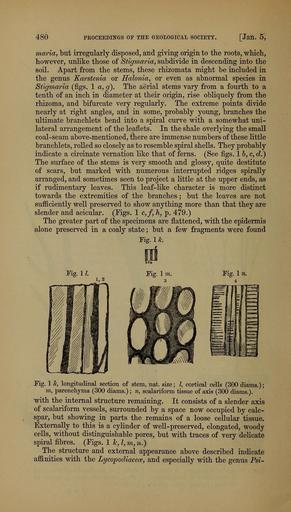MAKE A MEME
View Large Image

| View Original: | The_Quarterly_journal_of_the_Geological_Society_of_London_(12981038425).jpg (1162x2045) | |||
| Download: | Original | Medium | Small | Thumb |
| Courtesy of: | commons.wikimedia.org | More Like This | ||
| Keywords: The Quarterly journal of the Geological Society of London (12981038425).jpg 480 <br> PROCEEDINGS OF THE GEOLOGICAL SOCIETY <br> Jan 5 <br> maria but irregularly disposed and giving origin to the roots which <br> however unlike those of Stigmaria subdivide in descending into the <br> soil Apart from the stems these rhizomata might be included in <br> the genus Karstenia or Halonia or even as abnormal species in <br> Stigmaria figs 1 a g The aerial stems vary from a fourth to a <br> tenth of an inch in diameter at their origin rise obliquely from the <br> rhizoma and bifurcate very regularly The extreme points divide <br> nearly at right angles and in some probably young branches the <br> ultimate branchlets bend into a spiral curve with a somewhat uni- <br> lateral arrangement of the leaflets In the shale overlying the small <br> coal-seam above-mentioned there are immense numbers of these little <br> branchlets rolled so closely as to resemble spiral shells They probably <br> indicate a circinate vernation like that of ferns See figs 1 c d <br> The surface of the stems is very smooth and glossy quite destitute <br> of scars but marked vdth numerous interrupted ridges spirally <br> arranged and sometimes seen to project a little at the upper ends as <br> if rudimentary leaves This leaf-like character is more distinct <br> towards the extremities of the branches ; but the leaves are not <br> sufficiently weU preserved to show anything more than that they are <br> slender and acicular Figs 1 c f 7i p 479 <br> The greater part of the specimens are flattened with the epidermis <br> alone preserved in a coaly state ; but a few fragments were found <br> Fig 1 k <br> Fig 1 1 <br> Fig 1 k longitudinal section of stem nat size ; I cortical cells 300 diams ; <br> m parenchyma 300 diams ; n scalariform tissue of axis 300 diams <br> with the internal structure remaining It consists of a slender axis <br> of scalariform vessels surrounded by a space now occupied by calc- <br> spar but showing in parts the remains of a loose cellular tissue <br> Externally to this is a cylinder of weU-preserved elongated woody <br> cells without distinguishable pores but with traces of very delicate <br> spiral fibres Figs 1 k I m n <br> The structure and external appearance above described indicate <br> affinities with the Lycopodiacem and especially with the genus Psi- 36162045 111474 51125 Page 480 Text v 15 http //www biodiversitylibrary org/page/36162045 1859 Geological Society of London NameFound Halonia NameConfirmed Halonia Fr 1849 EOLID 6423499 NameBankID 9710737 NameFound Karstenia NameConfirmed Karstenia EOLID 13192795 NameBankID 236823 NameFound Stigmaria NameConfirmed Stigmaria EOLID 6133541 NameBankID 4853119 Biodiversity Heritage Library The Quarterly journal of the Geological Society of London v 15 1859 Geology Periodicals Smithsonian Libraries bhl page 36162045 dc identifier http //biodiversitylibrary org/page/36162045 smithsonian libraries Information field Flickr posted date ISOdate 2014-03-07 Check categories 2015 August 26 CC-BY-2 0 BioDivLibrary https //flickr com/photos/61021753 N02/12981038425 2015-08-26 14 58 01 cc-by-2 0 PD-old-70-1923 The Quarterly journal of the Geological Society of London 1859 Photos uploaded from Flickr by Fæ using a script | ||||